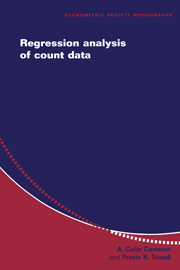Book contents
- Frontmatter
- Contents
- List of Figures
- List of Tables
- Preface
- 1 Introduction
- 2 Model Specification and Estimation
- 3 Basic Count Regression
- 4 Generalized Count Regression
- 5 Model Evaluation and Testing
- 6 Empirical Illustrations
- 7 Time Series Data
- 8 Multivariate Data
- 9 Longitudinal Data
- 10 Measurement Errors
- 11 Nonrandom Samples and Simultaneity
- 12 Flexible Methods for Counts
- Appendices
- References
- Author Index
- Subject Index
- Titles in the series
10 - Measurement Errors
Published online by Cambridge University Press: 05 January 2013
- Frontmatter
- Contents
- List of Figures
- List of Tables
- Preface
- 1 Introduction
- 2 Model Specification and Estimation
- 3 Basic Count Regression
- 4 Generalized Count Regression
- 5 Model Evaluation and Testing
- 6 Empirical Illustrations
- 7 Time Series Data
- 8 Multivariate Data
- 9 Longitudinal Data
- 10 Measurement Errors
- 11 Nonrandom Samples and Simultaneity
- 12 Flexible Methods for Counts
- Appendices
- References
- Author Index
- Subject Index
- Titles in the series
Summary
Introduction
The well-known bivariate linear errors-in-variables regression model with additive measurement errors in both variables provides one benchmark for nonlinear errors-in-variables models. The standard textbook treatment of the errors-invariables case emphasizes the attenuation result, which says that the estimated least squares estimate of the slope parameter is downward-biased if both variables are subject to measurement error. The essential problem lies in the correlation between the observed explanatory variable and the measurement error. This leads to distorted inferences about the role of the covariate. Although this result does not always extend to general cases, such as a linear model with two or more covariates measured with error, it is usually of interest to consider whether a similar attenuation bias exists generally in nonlinear models (Carroll et al., 1995).
There are important similarities and differences between measurement errors in nonlinear and linear models. First, in nonlinear models it may be more natural to allow measurement errors to enter multiplicatively rather than additively. Second, models in which the measurement errors are confined to the count variable, rather than covariates, are of considerable interest. Third, the direction of measurement errors in count models is sometimes strongly suspected from a priori analysis, which permits stronger conclusions.
Given these motivations, this chapter considers estimation and inference in the presence of measurement errors in exposure time, errors due to underreporting and misclassification of events. Such errors are shown to have important consequences for model identification, specification, estimation, and testing.
- Type
- Chapter
- Information
- Regression Analysis of Count Data , pp. 301 - 325Publisher: Cambridge University PressPrint publication year: 1998

